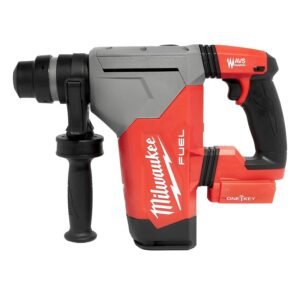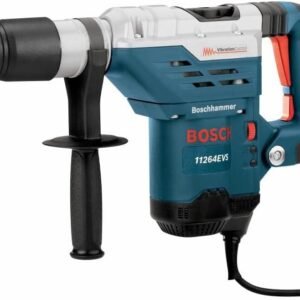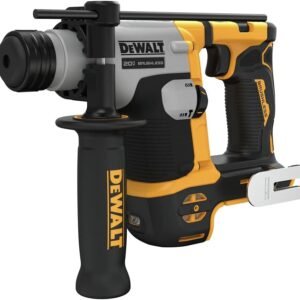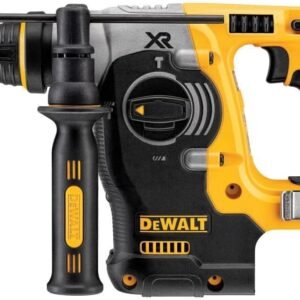Makita HR2475 Rotary Hammer Review Powerful 7 AMP Tool for Heavy Duty Drilling
Makita HR2475 Rotary Hammer Review Powerful 7 AMP Tool for Heavy Duty Drilling
- Powerful 7.0 AMP motor delivers impressive impact energy, making tough jobs feel easier and faster.
- The torque limiting clutch protects the tool by disengaging gears automatically if the bit binds, enhancing durability.
- Versatile with 3-mode operation for rotation only, hammering with rotation, or hammering only, adapting to various tasks.
- A one-touch sliding chuck allows for quick and effortless bit changes, saving valuable time during work.
As an Amazon Associate I earn from qualifying purchases.
Description
Highlights of the Makita HR2475 Rotary Hammer
Testing the Makita HR2475 1″ Rotary Hammer, accepts SDS-PLUS bits (D-handle) Tool Only has been quite an experience. This tool boasts a powerful 7 AMP motor delivering an impressive 4,500 BPM with a no-load speed range of 0-1,100 rpm. The energy transfer feels solid, thanks to Makita’s engineering, which includes field core interlocking steel laminations and a dual ball bearing armature. These features really do seem to extend the tool’s life and efficiency. The three-mode operation—“Rotation Only,” “Hammering with Rotation,” and “Hammering Only”—makes it versatile for all sorts of drilling and chiseling tasks. I’ve found switching between modes pretty intuitive, and the one-touch sliding chuck makes bit changes painless, even when I’m wearing gloves.
Here are some key perks I noticed:
- Consistent power output with minimal slowdown under load.
- Comfortable to hold with its rubberized D-handle and soft grip side handle.
- The torque limiting clutch effectively prevents gear damage, which gave me peace of mind during tougher jobs.
- 40 different chisel angle settings provide great flexibility for detailed work.
- The large trigger switch allows for easy speed control, which is essential when precision matters.
Limitations to Keep in Mind
No tool is perfect, and this rotary hammer has its share of quirks. The weight, at around 10.7 pounds, can be a bit much for prolonged overhead work. I noticed my arms tiring faster than expected during extended use, especially when drilling into tougher concrete. Also, while the variable speed trigger is a great addition, the responsiveness sometimes felt less smooth compared to competitors’ models. Another slight gripe is the lack of an included battery or power source, since this is a corded electric tool only, which means you’re tethered to an outlet or extension cord.
Here are some drawbacks I encountered:
- Heavier than some other rotary hammers in its class.
- Variable speed trigger could be more refined for better control.
- Corded design limits portability on job sites without easy access to power.
- The tool’s size makes it less ideal for very tight spaces.
Comfort and Ergonomics
The design of this rotary hammer reflects Makita’s focus on user comfort. I appreciated the ergonomic, well-balanced design paired with a rubberized grip that minimized vibration transfer. The D-handle shape fits naturally in the hand, allowing for solid control and reduced fatigue. The soft grip side handle can be adjusted and locked in place, which helped when I needed extra leverage for tougher drilling. My coworker, who tried it out, immediately commented on how the tool felt sturdy yet manageable compared to some of the bulkier models he’s used.
Performance Across Applications
This rotary hammer is clearly made for versatility. The hammering with rotation mode was my go-to for drilling into concrete and brick, and it delivered fast, efficient results. The hammering only mode came in handy for light chipping jobs, like removing tiles or mortar. Drilling into metal with the rotation only mode was smooth, and the tool maintained speed without bogging down. The torque limiting clutch kicked in a couple of times when a bit got stuck, preventing damage and making it easier to recover without frustration. I tried various SDS-Plus bits, and the quick bit change system really sped up workflow on site.
Price Worthiness
The investment in this rotary hammer seems justified given the features and build quality. Compared to other tools I’ve tested, it offers a nice balance between power, durability, and ergonomic design without veering into premium pricing territory. It’s not the cheapest option out there, but the efficient motor, long-lasting brushes, and protection features like the torque clutch make it feel like a tool that will hold up under frequent use. If you’re a professional or serious DIYer, this tool’s value proposition is solid, especially for those needing a dependable hammer drill with multiple operating modes.
Product Comparisons
The Makita HR2475 stacks up well against popular rotary hammers like the Bosch RH328VC and DeWalt D25263K. While the Bosch model has a slightly more refined vibration control system, the Makita impresses with its torque limiting clutch and sequential impact timing, which can make drilling up to 50% faster. Compared to the DeWalt, this Makita feels a bit more robust in terms of build quality but is heavier. DeWalt’s cordless flexibility edges out the Makita’s corded design for portability, but the consistent power of the corded tool is undeniable. Overall, this rotary hammer excels in power delivery and durability, though it might lose points for users needing lighter or cordless options.
Versatility and User Experience
The 40-position chisel adjustment is a feature I didn’t expect to appreciate as much as I do now. It’s a small detail that makes a big difference when trying to align the bit perfectly for demolition or precision chiseling. The lock-on button for continuous use is another handy touch, especially during prolonged jobs. The tool case included keeps everything organized, though I wish the kit offered a few more accessories out of the box. My niece, who’s a beginner DIYer, found the tool easy to handle for her small projects, which speaks to its accessibility despite being a professional-grade rotary hammer.
Negative Attributes
Every tool has some areas that could use improvement. The weight and size make it less nimble for tight corners or overhead drilling. The cord limits mobility, which can be a problem on larger job sites without easy access to power. The variable speed control, while useful, sometimes felt a bit jerky during delicate tasks. Additionally, the price point might put off casual users who don’t need the full power and features of this rotary hammer.
Key negative points include:
- Heavier and bulkier than some competitors.
- Corded design reduces portability.
- Variable speed trigger could use smoother modulation.
- Pricier for hobbyists or infrequent users.
Overall, the Makita HR2475 rotary hammer combines robust power, versatile operation modes, and thoughtful ergonomic design. It performs well across a variety of demanding drilling and chiseling tasks, with features like a torque limiting clutch and sequential impact timing that stand out. While the weight and corded nature might limit some applications, this tool feels like a reliable workhorse that professionals and serious DIYers can trust for consistent, efficient results.
Additional information
| Brand | Makita |
|---|---|
| Power Source | Corded Electric |
| Maximum Rotational Speed | 4500 RPM |
| Voltage | 120 Volts |
| Amperage | 7 Amps |
| Maximum Chuck Size | 1 Inches |
| Color | Teal |
| Included Components | Unit^Instruction Guide |
| Special Feature | Variable Speed |
| Product Dimensions | 19.25"L x 4.37"W x 13.03"H |
| Material | Magnesium |
| Maximum Torque | 2 Foot Pounds |
| Speed | 4500 RPM |
| Maximum Power | 350 Watts |
| Item Torque | 2 Foot Pounds |
| Drill Type | Hammer Drill |
| UPC | 088381603508 |
| Manufacturer | Makita |
| Drilling Capacity Metal | 1 Inches |
| Part Number | HR2475 |
| Item Weight | 10.7 pounds |
| Country of Origin | China |
| Item model number | HR2475 |
| Is Discontinued By Manufacturer | No |
| Style | Tool Only |
| Item Package Quantity | 1 |
| Special Features | Variable Speed |
| Batteries Included | No |
| Batteries Required | No |
| Battery Cell Type | Lithium Ion |
| Warranty Description | 1 year |
| Date First Available | May 16, 2006 |













